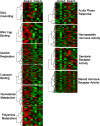Microarray analysis identifies distinct gene expression profiles associated with histological subtype in human osteosarcoma
- PMID: 20340016
- PMCID: PMC3047650
- DOI: 10.1007/s00264-010-0996-6
Microarray analysis identifies distinct gene expression profiles associated with histological subtype in human osteosarcoma
Abstract
Osteosarcoma is the most common primary malignant bone tumour. Currently osteosarcoma classification is based on histological appearance. It was the aim of this study to use a more systematic approach to osteosarcoma classification based on gene expression analysis and to identify subtype specific differentially expressed genes. We analysed the global gene expression profiles of ten osteosarcoma samples using Affymetrix U133A arrays (five osteoblastic and five non-osteoblastic osteosarcoma patients). Differential gene expression analysis yielded 75 genes up-regulated and 97 genes down-regulated in osteoblastic versus non-osteoblastic osteosarcoma samples, respectively. These included genes involved in cell growth, chemotherapy resistance, angiogenesis, steroid- and neuropeptide hormone receptor activity, acute-phase response and serotonin receptor activity and members of the Wnt/ß-catenin pathway and many others. Furthermore, we validated the highly differential expression of six genes including angiopoietin 1, IGFBP3, ferredoxin 1, BMP, decorin, and fibulin 1 in osteoblastic osteosarcoma relative to non-osteoblastic osteosarcoma. Our results show the utility of gene expression analysis to study osteosarcoma subtypes, and we identified several genes that may play a role as potential therapeutic targets in the future.
Figures



Similar articles
-
mRNA expression profiles of primary high-grade central osteosarcoma are preserved in cell lines and xenografts.BMC Med Genomics. 2011 Sep 20;4:66. doi: 10.1186/1755-8794-4-66. BMC Med Genomics. 2011. PMID: 21933437 Free PMC article.
-
Identification of CD20, ECM, and ITGA as Biomarkers for Osteosarcoma by Integrating Transcriptome Analysis.Med Sci Monit. 2016 Jun 17;22:2075-85. doi: 10.12659/msm.898852. Med Sci Monit. 2016. PMID: 27314445 Free PMC article.
-
An expression signature classifies chemotherapy-resistant pediatric osteosarcoma.Cancer Res. 2005 Mar 1;65(5):1748-54. doi: 10.1158/0008-5472.CAN-04-2463. Cancer Res. 2005. PMID: 15753370
-
Molecular classification of osteosarcoma.Cancer Treat Res. 2009;152:459-65. doi: 10.1007/978-1-4419-0284-9_26. Cancer Treat Res. 2009. PMID: 20213408 Review.
-
DNA microarrays in pediatric cancer.Cancer J. 2001 Jan-Feb;7(1):2-15. Cancer J. 2001. PMID: 11269644 Review.
Cited by
-
Prostate Cancer Cell Extracellular Vesicles Increase Mineralisation of Bone Osteoblast Precursor Cells in an In Vitro Model.Biology (Basel). 2021 Apr 10;10(4):318. doi: 10.3390/biology10040318. Biology (Basel). 2021. PMID: 33920233 Free PMC article.
-
Regenerative therapy with mesenchymal stem cells at the site of malignant primary bone tumour resection: what are the risks of early or late local recurrence?Int Orthop. 2014 Sep;38(9):1825-35. doi: 10.1007/s00264-014-2384-0. Epub 2014 Jun 7. Int Orthop. 2014. PMID: 24906983
-
Augmented expression of urokinase plasminogen activator and extracellular matrix proteins associates with multiple myeloma progression.Clin Exp Metastasis. 2014 Jun;31(5):585-93. doi: 10.1007/s10585-014-9652-7. Epub 2014 May 8. Clin Exp Metastasis. 2014. PMID: 24807734
-
Ferredoxin 1 is a cuproptosis-key gene responsible for tumor immunity and drug sensitivity: A pan-cancer analysis.Front Pharmacol. 2022 Sep 21;13:938134. doi: 10.3389/fphar.2022.938134. eCollection 2022. Front Pharmacol. 2022. PMID: 36210836 Free PMC article.
-
Human Metaplastic Breast Carcinoma and Decorin.Cancer Microenviron. 2017 Dec;10(1-3):39-48. doi: 10.1007/s12307-017-0195-8. Epub 2017 Jun 26. Cancer Microenviron. 2017. PMID: 28653173 Free PMC article.
References
-
- Davis AM, Bell RS, Goodwin PJ. Prognostic factors in osteosarcoma: a critical review. J Clin Oncol. 1994;12:423–431. - PubMed
-
- Hudson M, Jaffe MR, Jaffe N, et al. Pediatric osteosarcoma: therapeutic strategies, results, and prognostic factors derived from a 10-year experience. J Clin Oncol. 1990;8:1988–1997. - PubMed
MeSH terms
Substances
LinkOut - more resources
Full Text Sources
Medical
Miscellaneous

